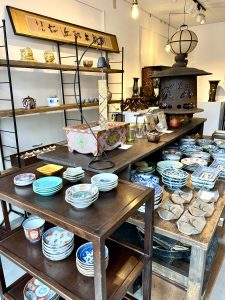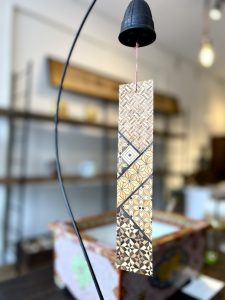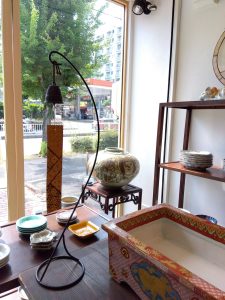心に染みるものも年々変わります(愛知県名古屋市千種区姫池通 骨董買取 古美術風光舎)
2024.06.02
皆さまこんにちは。スタッフHでございます。
最近はマメに天気をチェックするようにしていて、今日は曇り空だと思い込んでおりましたが、朝から雨が降っていて驚きました。お天気アプリをいくつか取り込んでいますが、個人的にこれ!というものが未だ見つからず、こんなに様々なAI技術が進歩しても自然相手の天気予報だけは難しいのだなと実感しております。

先日、天気予報会社を密着取材するテレビ番組を観る機会があり、気軽に見ている天気予報の裏側で、刻々と変化する空模様に翻弄され一喜一憂している社員の方々の姿が新鮮に映りました。予想が外れた時の利用者からの苦情がリアルで、真摯に受け止め落ち込んでいる社員を見ると、的中して当たり前だと思っている自分の思い込みを反省…。自然はそんなに甘いものではありませんね。
さてそんな雨模様の天気の中、少しでも湿気を吹き飛ばそうと店内の南部鉄器の風鈴を手動で無理やり鳴らしてみますと、まるでヨガなどで使用するティンシャの音のように余韻の続く心地よい音が響きます。思わず瞑想にふけってしまいそう…いえ気力が湧いてまいります。

Hello everyone. This is Staff H.
Recently, I have been checking the weather frequently and assumed that today would be cloudy, but I was surprised to find that it has been raining since this morning. I have been using several weather apps, but I haven’t found one that I personally like! I realize that even with all the advances in AI technology, it is still difficult to forecast the weather when dealing with nature.
The other day, I had an opportunity to watch a TV program that closely followed a weather forecasting company. Behind the scenes of the weather forecasts that we watch casually, I was struck by the fresh image of the employees who were both happy and sad at the mercy of the ever-changing sky conditions. The complaints from users when the forecast was wrong were very real, and when I saw the employees who took it seriously and were depressed, I reflected on my own assumption that it was natural that the forecast would be right on target…. Nature is not so sweet, is it?
In this rainy weather, I tried to blow off some of the humidity by manually ringing the Nambu ironware wind chime in the store, and the sound was pleasant and lingering, like the sound of a tingsha used in yoga. You will feel as if you are about to indulge in meditation…or rather, you will be energized.
The strip-like object on the wind chime is called a “tongue,” and the marquetry used for the tongue is a perfect match for Nambu ironware, creating an atmospheric atmosphere. The charm of this bell is that it is freestanding and can be placed anywhere.
The other day, when I was looking for postcards, I found a marquetry postcard for sale. The entire reverse side of the postcard is made of marquetry, and if you received such a postcard, you would be wondering where to put it.
There were such rare postcards, but the quantity and variety of postcards sold were surprisingly small overall. I had to ask the clerk to find them. There were many sets of letterheads and envelopes, and colorful message cards, but postcards? I had the impression that this was all there were. Is the demand for postcards decreasing? Certainly, the amount of greetings that can be written on a postcard can be done by mail, and it may seem inefficient to put a stamp on a postcard and have it take several days to reach the recipient. This may seem unthinkable to today’s younger generation.
Postcards are written in kanji (Chinese characters) as “postcards,” but the etymology of the word does not seem to have anything to do with leaves. In the old days, a memo written on a scrap of paper was called “Hashigaki,” and this is believed to be the origin of the word. In the Edo period (1603-1867), it was also called “Hashigaki” or “Hasho” and was a kind of reminder letter.
There are various theories as to why the word “hagaki” came to be written, but it seems to be related to the “tarayo” tree, which is designated as the post office tree. The leaves of the tarayoh tree are evergreen and long and slender, about 20 cm in length. If a sharp object or the tip of a fingernail is used to write letters or drawings on the underside of the leaves of this tree, the marks are discolored black and remain. It is said that the kanji character for “postcard” was used in Japan when samurai warriors wrote notes on these leaves and sent them.
Surprisingly, you can still mail a taraba leaf today as if it were a postcard, as long as you address it and affix an outside-the-box stamp. If you like to be surprised, why not give it a try? By the way, it must be a Tara-sama leaf.
Writing about postcards reminded me of a story I read as a child in an American picture book series called “Gama-kun to Kaeru-kun Series”. To help “Gama-kun,” a toad who is sad because he has never received a letter, “Frog-kun” hurries home to write a letter and gives it to “Snail-kun. Putting aside the question of why he wrote to a snail of all people, Frog invites Gama-kun to come back to his house and wait for the letter with him, but Gama-kun is sad, saying that no one will give him a letter anyway. Finally, Frog tells Gama-kun that he has written a letter, and the two of them wait happily at the door for the letter to arrive. Four days later, Mr. Snail finally arrives with the letter. It is an idyllic story, but at my age, it makes me think about many things and touches my heart.
See you next time.
*******************
ご実家の整理やお片付けなどをされている方のご相談などが多くございます。
お片付けなどくれぐれもご無理のないようになさってくださいませ。
風光舎では古美術品や骨董品の他にも絵画や宝石、趣味のお品など様々なジャンルのものを買受しております。
お片付けをされていて、こういうものでもいいのかしらと迷われているものでも、どうぞお気軽にご相談下さいませ。
また風光舎は、出張買取も強化しております。ご近所はもちろん、愛知県内、岐阜県、三重県その他の県へも出張いたします。
まずは、お電話お待ちしております。
愛知県名古屋市千種区姫池通
骨董 買取【古美術 風光舎 名古屋店】
TEL052(734)8444
10:00-18:00 OPEN



